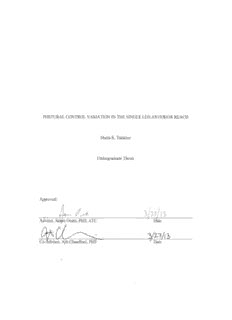
Untitled - The Ohio State University PDF
Preview Untitled - The Ohio State University
Postural Control Variation in the Single Leg Anterior Reach An Undergraduate Senior Thesis Presented in Accordance with the Requirements for Graduation with Research Distinction in Biomedical Engineering The Ohio State University Columbus, Ohio 43210 By Maria K. Talarico March 18, 2013 Oral Examination Committee Dr. James Onate, Advisor Dr. Ajit Chaudhari, Co-Advisor Copyright by Maria K. Talarico 2013 Abstract The single leg anterior reach (SLAR) is often used to assess dynamic postural control. However, the SLAR has yet to undergo a balance plate assessment of postural control that may yield information on the movement coordination strategy utilized during the SLAR. The goal of this study is to examine the effect of different postural control strategies utilized to complete SLAR. Subjects included 31 male professional lacrosse athletes (26.7±2.87 years, 1.82±0.07 m, and 89.7±11.1 kg) and 15 NCAA Division 1 female volleyball athletes (19.4±1.15 years, 1.82±0.08 m, and 75.6±7.6 kg) who performed balance plate instrumented SLAR measurements. Center of pressure (CoP) position data were collected during each trial via a portable balance plate and the CoP excursion (CoPE) for each trial was calculated. CoPE was dichotomized into high (greater movement variability) and low (lower movement variability). Between group t-tests were performed between high vs. low CoPE groups to assess normalized reach distance between movement strategy with an alpha level set at .05. Reach distance was significantly higher in those with higher CoPE in the frontal plane (Left: 62.22±3.90 cm high excursion (HE), 60.96±4.07 cm low excursion (LE), Right: 62.32±3.87 cm HE, 60.86±4.07 cm LE) and total CoPE for the right leg (61.92±5.46 cm for HE and 59.87±4.27 cm for LE). Reach distance was greater in those with higher CoPE in the sagittal plane (Left: 63.45±4.27 cm HE, 59.73±2.68 cm LE, Right: 62.39±5.56 cm HE, 59.40±3.82 cm LE) and total CoPE for the left leg (62.32±3.87 cm for HE and 60.86±4.07 cm for LE). Increased frontal plane movement variability during a sagittal reach SLAR task resulted in greater reach performance. These findings may have clinical implications for individuals demonstrating a lack of movement variability in the frontal plane resulting in lower sagittal plane reach distances. Improvements to frontal plane movement variability strategies may result in increased dynamic postural control. ii Acknowledgments I would like to thank my family, especially my parents and sister, friends, Dr. Onate, Dr. Chaudhari, members of the MOVES Lab, especially Dustin Grooms and Meghan Miller, the Ohio Machine Lacrosse team, the Ohio State University Women’s Varsity Volleyball team, the Biomedical Engineering Department and the College of Engineering at the Ohio State University for all of their support and help in making this research possible. iii Table of Contents Abstract........................................................................................................................................ii Acknowledgements......................................................................................................................iii List of Figures..............................................................................................................................vii List of Tables................................................................................................................................viii Chapter 1......................................................................................................................................1 1.1 Neuromuscular Control..............................................................................................1 1.1.1 Definition.....................................................................................................1 1.1.2 Components.................................................................................................1 1.1.3 Assessment..................................................................................................2 1.1.4 Neuromuscular Control Intervention...........................................................2 1.2 Balance........................................................................................................................3 1.2.1 Definition.....................................................................................................3 1.3 Postural Control..........................................................................................................3 1.3.1 Definition and Categories............................................................................3 1.3.2 Static Postural Control.................................................................................4 1.3.3 Dynamic Postural Control............................................................................4 1.3.4 Implications for Athletes – Postural Control Risk Identification.................5 1.3.5 Implications for Athletes – Pathologies.......................................................5 1.3.6 Implications for Athletes – Exercise Interventions......................................7 1.4 Postural Control Strategies.........................................................................................7 1.4.1 Postural Stability Strategy...........................................................................7 1.4.2 Postural Variability Strategy.......................................................................8 1.4.3 Postural Control Strategy Integration..........................................................8 Chapter 2......................................................................................................................................9 2.1 Clinical Measures.......................................................................................................9 iv 2.2 Force Plates.................................................................................................................9 2.2.1 Definition.....................................................................................................9 2.2.2 Types...........................................................................................................9 2.2.3 Variables Measured.....................................................................................10 2.2.4 Balance Assessment....................................................................................11 2.3 Center of Pressure......................................................................................................11 2.3.1 Definition.....................................................................................................11 2.3.2 Balance Assessment....................................................................................11 2.3.3 Excursion Length.........................................................................................12 2.3.4 Velocity........................................................................................................12 2.3.5 Sway Area....................................................................................................13 2.4 Single-Leg Balance Assessments...............................................................................13 2.4.1 Balance Assessment Implications.................................................................13 2.4.2 Star Excursion Balance Test........................................................................14 2.4.3 Y Balance Test.............................................................................................16 2.4.4 Single-Leg Anterior Reach...........................................................................17 Chapter 3.......................................................................................................................................18 3.1 Introduction.................................................................................................................18 3.2 Purpose........................................................................................................................18 3.3 Hypothesis...................................................................................................................18 3.4 Subjects.......................................................................................................................19 3.5 Equipment and Instrumentation..................................................................................19 3.6 Procedure....................................................................................................................19 3.7 Testing Methods.........................................................................................................20 3.8 Statistical Analysis......................................................................................................21 3.9 Results.........................................................................................................................21 3.10 Discussion.................................................................................................................22 v 3.11 Future Research.........................................................................................................23 3.11 Limitations.................................................................................................................24 Figure 1.........................................................................................................................................26 Figure 2.........................................................................................................................................27 Figure 3.........................................................................................................................................28 Figure 4.........................................................................................................................................29 Figure 5.........................................................................................................................................30 Figure 6.........................................................................................................................................31 Figure 7.........................................................................................................................................32 Figure 8.........................................................................................................................................33 Figure 9.........................................................................................................................................34 Figure 10.......................................................................................................................................35 Figure 11.......................................................................................................................................36 Table 1...........................................................................................................................................37 Table 2...........................................................................................................................................38 Table 3...........................................................................................................................................39 References.....................................................................................................................................40 vi List of Figures Figure 1: The Star Excursion Balance Test for reaching with the right leg Figure 2: Y Balance Test – Upper Extremity Figure 3: Single Leg Anterior Reach Figure 4: Center of pressure excursion in the (a) x axis, (b) y axis, and (c) total excursion Figure 5: Matlab plot of center of pressure position data in the y axis versus the center of pressure position data in the x axis for a subject’s left leg SLAR trial Figure 6: Left SLAR maximum reach distance normalized to leg length (%LL) for low CoP excursion in the y axis (sagittal plane) and high CoP excursion in the y axis Figure 7: Left SLAR maximum reach distance normalized to leg length (%LL) for low CoP excursion in the x axis (frontal plane) and high CoP excursion in the x axis Figure 8: Left SLAR maximum reach distance normalized to leg length (%LL) for low CoP total excursion and high CoP total excursion Figure 9: Right SLAR maximum reach distance normalized to leg length (%LL) for low CoP excursion in the y axis (sagittal plane) and high CoP excursion in the y axis Figure 10: Right SLAR maximum reach distance normalized to leg length (%LL) for low CoP excursion in the x axis (frontal plane) and high CoP excursion in the x axis Figure 11: Right SLAR maximum reach distance normalized to leg length (%LL) for low CoP total excursion and high CoP total excursion vii List of Tables Table 1: Center of pressure dichotomized excursion (50th percentile excursion) for CoPx, CoPy, and CoPtotal for the left and right leg Table 2: Left SLAR mean reach distances dichotomized for low and high center of pressure excursion in the x and y direction and total excursion Table 3: Right SLAR mean reach distances dichotomized for low and high center of pressure excursion in the x and y direction and total excursion viii
Description: